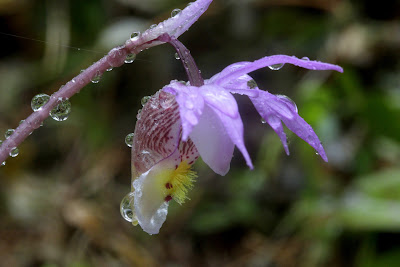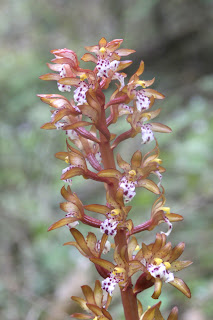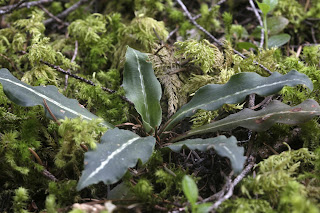I had to lead a field trip for the Washington Native Plant Society on Whidbey and Fidalgo Islands on May 18 and did some orchid hunting along the way and in preparation for the field trip. I found five species in bloom and several additional varieties, the first orchids of the year for me. The plants all seemed sparse this year, especially on the west side of the mountains where an unusual winter was followed by a hot and dry spring.
I stopped first in north-central Washington to see if the Eastern Fairy Slippers were blooming there. They had just started and I found about six plants in flower, but it was raining and I did not linger or explore further than the area we were acquainted with.
Calypso bulbosa var. americana
Eastern Fairy Slipper
I went on to the west side of the Cascades and hike the Thunder Creek trail looking for the Western Fairy Slipper but they were nearly finished even at that elevation and I only found a couple of plants. Also found two different Listeras in bloom there.
Calypso bulbosa var. occidentalis
Western Fairy Slipper
The Northwestern Twayblade was just starting to bloom and I found a few open flowers. Both the red and green forms of the Heart-leaved Twayblade were blooming but there were far fewer of them than I am used to seeing that area. I had difficulty finding just a few of them.
Listera (Neottia) banksiana
Northwestern Twayblade
Listera (Neottia) cordata var. nephrophylla
Heart-leaved Twayblade (green form)
Listera (neottia cordata var. nephrophylla fma. rubescens
Heart-leaved Twayblade (red form)
Later in preparation for the field trip I visited a number of different sites and found a few Western Spotted Coralroot blooming where I had expected to find many of them. I also found some Western Coralroot but they were only just beginning to bloom.
Corallorhiza maculata var. occidentalis
Western Spotted Coralroot
Corallorhiza mertensiana
Western Coralroot
At a number of locations I found the Giant Rattlesnake Orchid but it was a long way from blooming, as I expected. I did, however, take some photos of the leaves including some that showed the beautiful reticulation that is sometimes seen.
Goodyera oblongifolia







































9 comments:
Super cool, Ron. Love all the pictures and descriptions of your roamings. Perhaps the flowers will be more prevalent next year? I'm glad you were able to find some though! Thanks for the glorious show!
Thanks, Janet. Appreciate the comments.
Awesome finds! I can't wait to see what else you find in the coming season! It was your article in the April 2011 issue of Orchids that first inspired me to hunt for native orchids in my home state of Montana, many thanks!! Also, I would like to invite you to join iNaturalist (if you haven't already) we have a small, but enthusiastic orchid hunting community there and we would love to have you! inaturalist.org
Cheers,
Ansel
Thanks, Ansel. We are out hunting again. Will do a post when we return but are down in northern California at the moment.
I found a strange coralroot. It looks like a western spotted coralroot but it has no spot. What do you think it is?
I'd have to see it to be sure. Western Spotted Coralroots come in a rainbow of colors.
I posted photos on Flickr. https://flic.kr/p/2jn58t2 https://flic.kr/p/2jn3YLy
It's a Spotted Coralroot. A somewhat similar form has been identified as the Ozette Coralroot, a named variety, but the species is so variable that that is almost certainly incorrect. This is an good example of the kind of variation one finds in the species.
Thank you, Ron. Your answer is interesting.
Post a Comment